Teaching others the key to bettering themselves is an incredibly rewarding experience, but if you work with your clients in person, you're limited to your local area. What if your impact could reach all around the globe, make you money, and require much less time than teaching fitness classes all day long?
All of this is possible when you sell fitness programs online.
Online fitness, workout, and nutrition programs have become massively popular in recent years, and if you choose to ride that wave and start selling your own, you'll be on the path to launching a successful business.
You can sell online fitness programs in more ways than one, and the best way to do so is with Whop. There are several ways to sell fitness content too. Not sure where to begin? Don't worry—we've got you.
Our comprehensive guide to selling fitness programs will tell you what to sell, how to get started step-by-step, and how to turn your passion for fitness into a highly profitable online business.
Can You Make Money Selling Workout Programs?
Selling workout programs over the internet sounds pretty cool, but does it actually pay any money? More importantly, is there any future in it?
The short answer to both of those questions is a resounding "yes" - but we'll elaborate.
The earning potential in this industry is high, all thanks to the fact that you can have many different sources of income. Personal trainers who work online can offer subscriptions, run paid communities, sell digital products (such as pre-recorded fitness classes), or even make their own apps to interact with their followers. All of this is usually supported by a social media presence, and that can generate extra money all on its own.
As with any digital business, you can start out small, but it is remarkably easy to scale up when selling fitness programs. If you choose the right platform to advertise and sell your content through, you can turn this into a full-time job, and a good one, too. On the other hand, if you are looking for a side hustle rather than a career, this can be an excellent source of passive income and a way to diversify the services you offer to your clients.
So how much can you make by selling fitness programs? As with anything, it varies, but subscriptions in this field are usually around $10 to $50 monthly. However, you could also sell one-on-one coaching or host online classes, and those can fetch even higher prices. Once you build up an audience, your income will grow exponentially.
Why Online Fitness?
The days of going to the gym or attending in-person classes aren't quite over, but people are increasingly eager to get their workout and nutritional advice online instead. Various market analyses underscore that fact, predicting that the global online fitness market will grow at a compound annual growth rate (CAGR) of 32.7% from 2023 to 2032. Money talks, so let's talk financial figures—the market was valued at $14.9 billion in 2022 and it's projected to reach a whopping $250.7 billion by 2032.
With such an optimistic outlook, now is the right time to jump on it and start getting paid for your fitness skills.
How to Sell Fitness, Nutrition, and Workout Programs Online

Are you a yoga teacher, a personal trainer, a powerlifter, or a CrossFit expert? No matter your specialization, you can make bank selling helpful content online. Below, we'll walk you through the whole process and help you set yourself up for success.
Step one: Prepare your content

Before you go through all the other factors of opening your own business, it's easiest to start by considering the kind of content you want to build it around. There are a lot of things you can do, and the best way to determine the scope of what you'll be selling is to start with the big picture and move on to the specifics.
To narrow down the content you want to make, ask yourself the following questions:
- Who is my target audience?
- What problems am I solving for my target audience?
- What do I want to teach, and how?
For instance, if you're hoping to be the ultimate go-to for people of all fitness levels, from beginner to pro, that will affect the scope of your content massively. On the other hand, if your audience is limited to beginners on a weight loss journey, you'll shift your focus toward what they can benefit from the most.
Next, depending on your audience, what content are you planning to prepare? Some of the most popular options include:
- workout videos
- pre-recorded classes
- challenges
- courses
- meal plans
- how-to videos
- fitness programs
- live training sessions
- access to fitness communities
- progress tracking tools
- bundles
With the initial planning stage out of the way, it's time to get to work and prepare some of that content in advance. You'll be updating it and adding to it throughout your online fitness career, but it's important to have a strong base that your customers can dig into right away and commit to a subscription or a one-time payment.
Step two: Pick a business model
Next, decide the business model you want to follow. You can also think of this as a pricing model, but it affects the entirety of your business, from the content you'll provide to the way you'll get paid.
The most popular business models in the online fitness industry include on-demand, once-off, and subscription-based. You can also go all out and offer all three options, catering to a wider range of customers!
On-demand is a model that lets customers purchase and access your content anytime they want, whereas one-off purchases mean that the customer pays once and gets access to one specific product or service instead of the entirety of your catalog.
The above models have some benefits and are useful for all types of content. For instance, if you have an extensive library of specialized workout videos, you can allow customers to pick just one, pay a fee, and be able to rewatch it as many times as they please. On the other hand, selling on-demand access to all of your content means a much larger payment, but it can also be harder to generate sales as many people may hesitate to spend that much upfront.
Subscriptions are pretty straightforward, and coincidentally, selling subscriptions is one of the best ways to make money online. With the subscription business model, your customers will pay on a regular basis, such as monthly, quarterly, or annually.
Thanks to subscriptions, you can build a loyal customer base, engage with your community, and get money coming in every month in smaller increments than with the on-demand model. However, keep in mind that you need to be making new content constantly to provide value and promote customer retention.
Of course, you could successfully employ all three strategies. If you sell fitness programs on Whop, you can set the pricing on every product and service that you offer, so it's possible to offer both subscriptions and on-demand payments.
Step three: Choose your platform
You've prepared your content and picked your business model—but where will you sell your online fitness programs?
Virtual trainers usually use one of (or a combination of) the following:
- mobile app
- personal website
- ecommerce platform
Fitness apps are all the rage right now. Popular across a variety of age groups, they're mostly used by millennials and Gen Z, but you can target all kinds of audiences. Using an app gives you the ability to reach more people than just running your own website.
Still, running your own website does have its advantages. The good side of it is that you'll have your own digital footprint and be able to post guides and videos all in one place. The downside is that, again, it'll cost you—both for the development and the upkeep. Coding is even more optional than in the case of apps, with website builders like Wix and Squarespace readily available. However, marketing a website can be tedious. Websites, unlike apps and marketplaces, aren't really listed anywhere other than Google, and there, you'll be faced with some tough competition.
One of the best ways to combine the two and get a lot more visibility is to list your services on an ecommerce platform like Whop. Getting started with Whop takes 10 minutes, and you can use it to offer the following:
- fitness courses
- booked lessons
- access to paid communities
- ebooks
- accountability templates
- and many more!
With Whop, you'll get access to everything you need to run a successful fitness business, making it the all-in-one platform of choice for virtual fitness entrepreneurs. You can use Whop in a number of ways. For starters, you can add the Whop API to your existing website or app and let it handle secure payments - however, Whop is also the best way to sell downloadables without a website.
Plus, you can sell access to paid Discord or Telegram communities, sell ebooks and fitness courses, or even build your own app.
Whop Apps seamlessly integrate with your products, allowing you to automate things like sending out content once a customer pays. Whop also helps you sync your calendar and allows customers to sign up for live training sessions, host giveaways, and chat with your community.
Step four: Plan out your marketing strategy

Even if you're the best fitness trainer in your area, the world at large may not have heard about you just yet. This is especially true if you don't have an established social media presence. No problem—all you need is a solid marketing strategy.
If you've listed your products and services on an ecommerce platform such as Whop, part of your marketing strategy pretty much takes care of itself. Your listing on the Whop Marketplace will be seen by thousands of customers who are looking for online fitness programs. At that point, all you need is a catchy product listing and a good range of services to offer, but some extra marketing never hurts.
Without an ecommerce platform with an established audience, marketing plays a key role in the success of your fitness programs.
Let's take a look at some of the key parts of marketing an online fitness business.
- Social media
Even those of us who aren't particularly fit enjoy a good workout video or a quick TikTok, which is part of what makes social media such a crucial marketing tool these days. Running your own social media profiles, including TikTok, Instagram, and Facebook, can help you build a following that will eventually go on to pay for your content on other platforms.
A good way to get started with social media is to sign up under your business name, which could even just be your actual name, and start posting relevant content, following similar accounts, and interacting with your audience.
It also helps to post some workout videos or tips for free, as that can get your future customers interested enough to sign up for your paid services! - Paid ads
While this is something to start doing only once your fitness programs are live and awaiting customers, paid ads are a great marketing strategy. You can use platforms like Facebook, Instagram, and Google to advertise your online business and boost your visibility. The downside is that ads are an investment and may cost a pretty penny.
Before paying for ads, think about your target demographic, their interests, and their goals. Next, set a budget that you're comfortable with and monitor the performance of your ads, making adjustments as needed. Later on, once your business is up and running, consider running a remarketing campaign that targets people who have interacted with your services but didn't end up buying anything. - Referrals
If you already work as a personal trainer, word of mouth is your best bet when it comes to marketing your online content. Refer your existing clients and offer them discounts if they sign up or follow you on social media.
Moreover, you can offer referral rewards to clients who buy your programs through Whop. Encouraging customers to participate in an affiliate program builds loyalty and potentially gets you some new business! - Effective SEO
Learning the basics of SEO can really help with organic marketing. If you can include relevant keywords in your product descriptions, in your storefront, or on your website, you'll get more visibility and a higher search ranking. For that reason, it also helps to keep your content updated and fresh so that search engines don't consider it irrelevant after a while!
Step five: Launch your business
You're now armed with a powerful arsenal. You have your skills which you've poured into some exciting workout content, and you're ready to start making money. All that remains is to get started.
Create a launch checklist to make sure that you're all set before your fitness programs go live and the first customers start buying them.
Here are some things to think of before your business goes live:
- Is your platform of choice all set up with your business name and description?
- Are your social media profiles live, and have you started posting relevant content on them?
- Do you have a bunch of workout videos, ebooks, and/or downloadables ready to go?
- Have you looked into what your competition is doing to craft compelling product descriptions?
- Have you planned out pricing models for all of your programs?
- Do you have eye-catching hero images, preferably featuring people, for every service and product that you offer?
- Are you ready to start running paid ads or advertise your business on social media?
If you've answered "yes" to all of the above, it's time to pull that trigger and start making money.
Selling Your Fitness Program With Whop
If you want to sell your fitness programs to a large established audience, benefit from automation, be able to get in-depth data about your business, and keep all of your services in one place, Whop is the way to go.
The setup process is incredibly simple and only takes minutes, which is a lot more than can be said about having to set up your own website!
Let's go over all the steps below, and by the end of this guide, you'll be ready to show your digital fitness products to the world.
Step one: Sign up with Whop
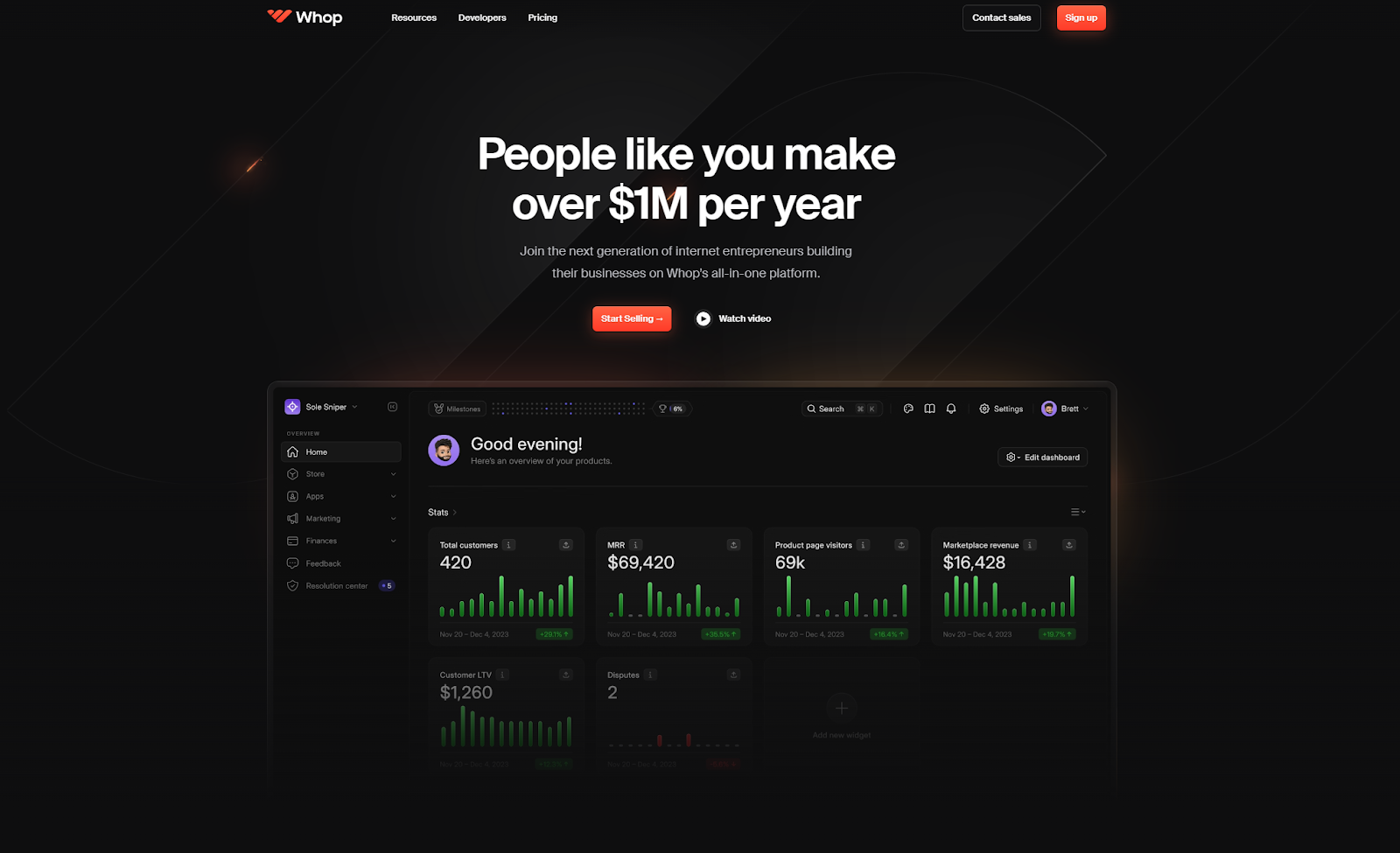
Signing up with Whop is as easy as pie. Head on over to the "Start Selling" page, type in your email and the name of your store (which you can change later if you'd like), and register to get started.
Step two: Set up your first product
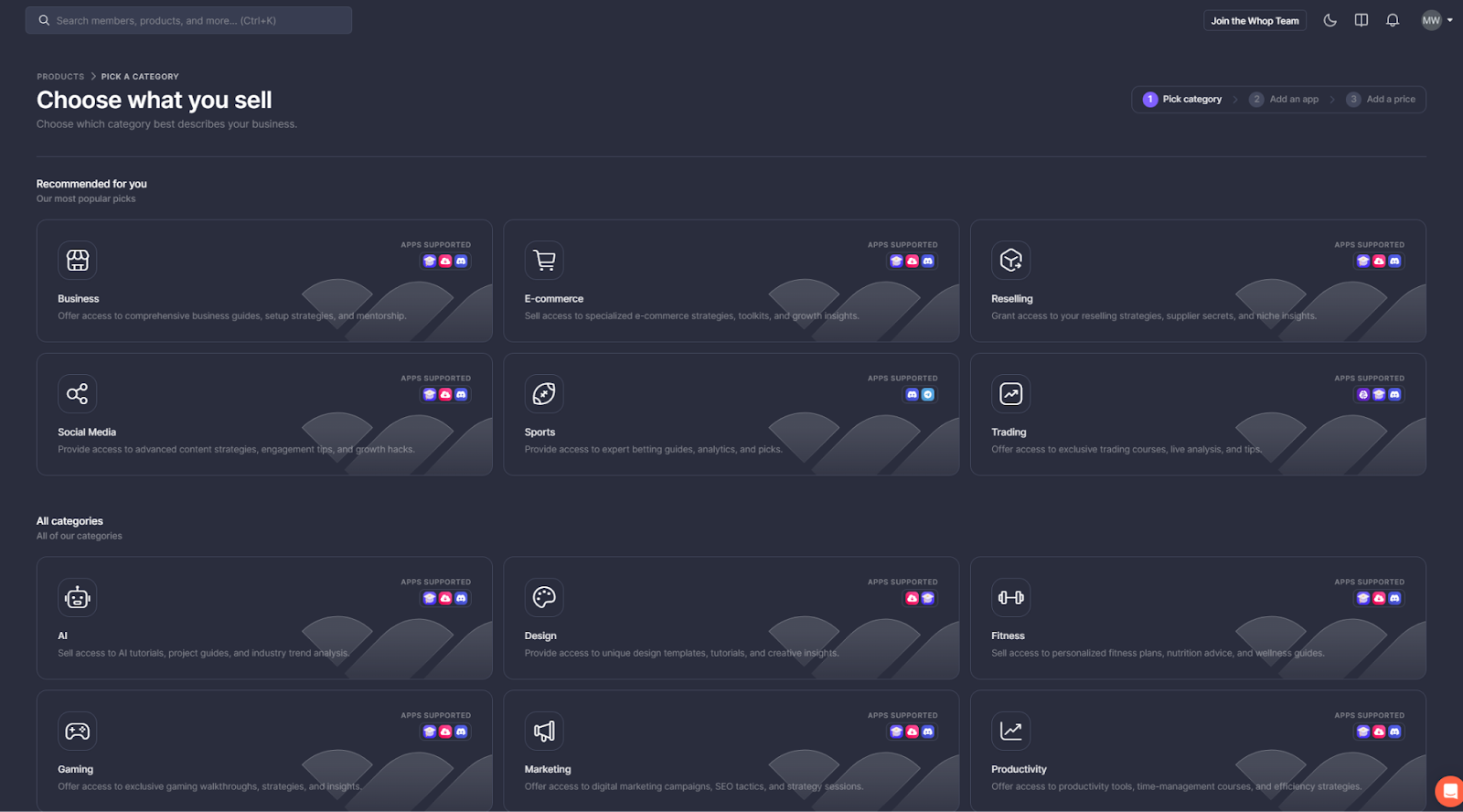
Once you sign in, you'll be greeted by the Whop Dashboard. This is your control center for all things related to your business!
As a first step, you'll want to click on "Set up product" on the Home tab. This takes you to a page where you can pick what you'll be selling. Don't worry if your services fall under multiple categories—you can always add more products or mix and match the ones you'll add at this stage.
No matter the exact content type, as a fitness trainer, scroll down to "All categories" and then click on "Fitness." Set up your product name at the top (and try to make the name informative)!
Step three: Pick the right product type
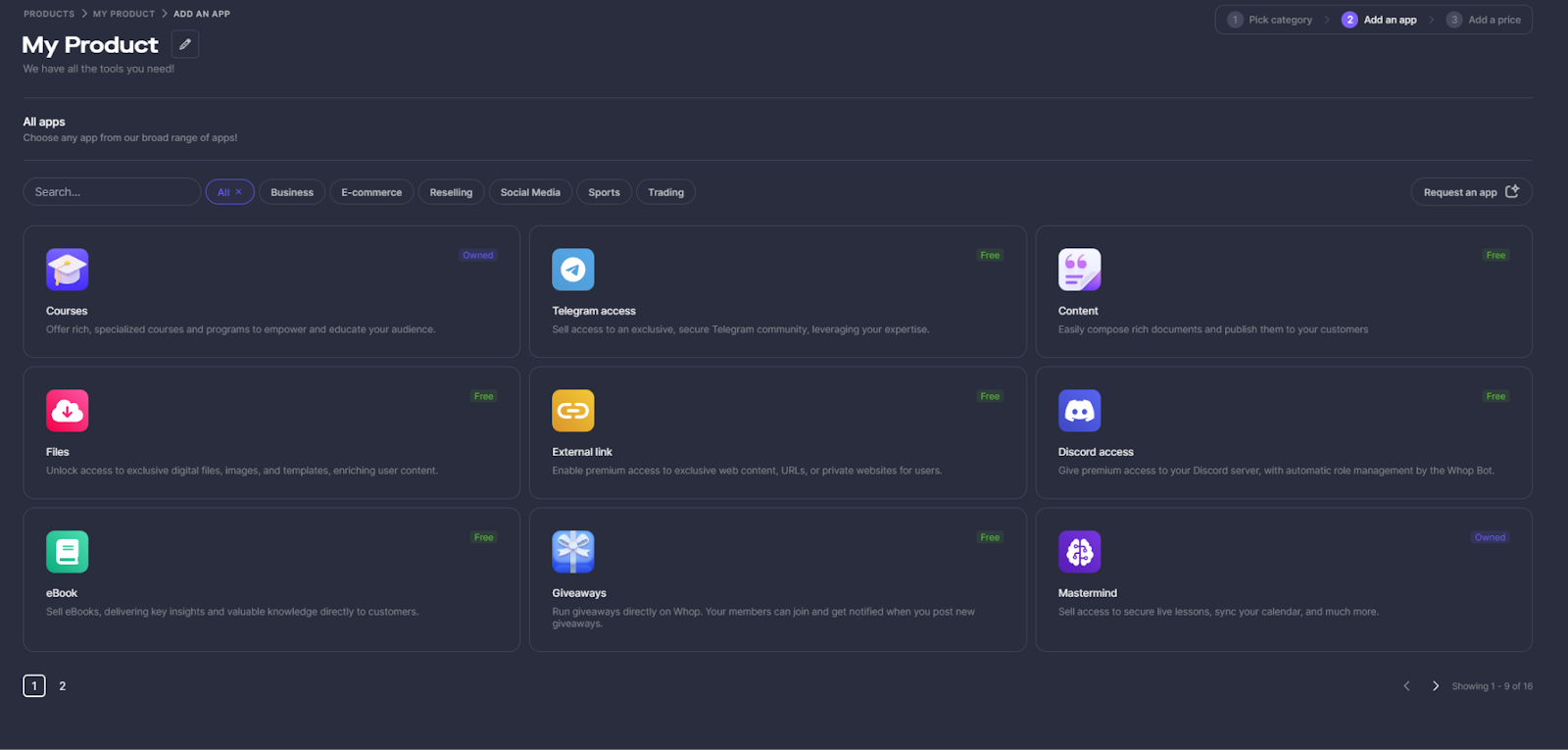
Still on that same page, you'll be given the option to pick from among Whop's vast library of apps and integration options. Now's the time to pick the option that best suits your service.
For instance, let's say that your first product is a 12-step training program that targets weight loss. No problem—just click on "Courses" and get started. On the other hand, if you're selling access to your awesome exclusive fitness community with helpful tips and peer motivation, choosing "Discord access" or "Telegram access" is your best bet.
You can also use Whop to sell access to software, restrict your web app to grant access only to paying customers (or even embed it into your Whop hub!), or sell access to live fitness lessons. Explore the options until you find the one that suits your product best, and then move on to the next step.
Step four: Set your price
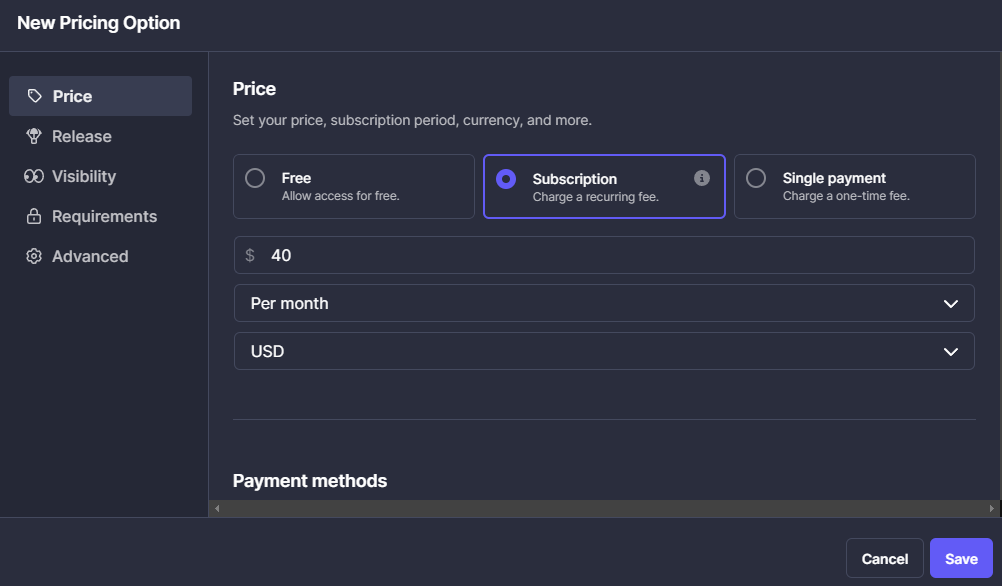
This is one of the exciting parts—you can set up various payment plans to get the money rolling in as soon as possible. On Whop, you can allow your customers to access some (or even all) content for free, set up subscription tiers, and accept one-time payments.
Let's say you want to offer subscriptions to your fitness program. Click on "Add pricing options," then "Subscription," and adjust how much you want to get paid, in what currency, and at what intervals. Whop lets you customize this to your heart's content, with subscription lengths ranging from 7 days to a whole year, as well as custom time periods. Customers can pay you with credit and debit cards, crypto, and PayPal.
Below those main options, you can choose to offer free trial days, add an extra one-time fee to the subscription, and offer discounts for customers who may want to cancel.
The process for setting up free and single-payment products is similar, so click around and check it out.
Step five: Write a product description
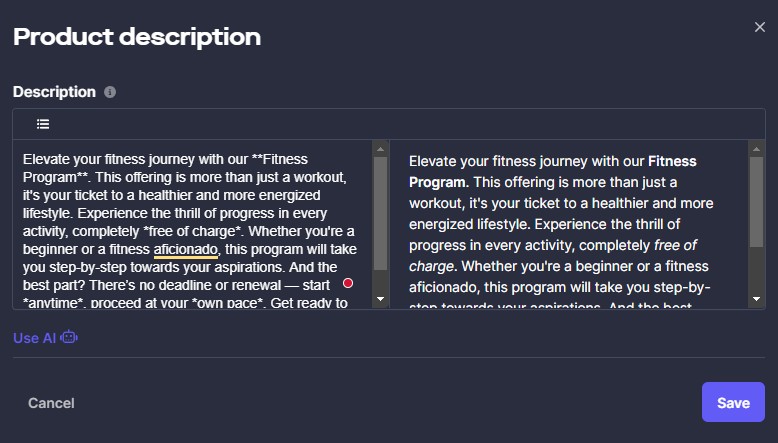
It's time to make your fitness program sound as appealing as possible with an informative and catchy product description. With Whop, you can use AI to help you craft it, which makes it a lot simpler. The AI will rely on information about your business and also be guided by the product name that you've chosen. You can also write the description by yourself from scratch.
To make sure your service gets as much attention as possible, spend some time checking out your competitors' listings and then tweak yours to perfection!
Step six: Customize your storefront
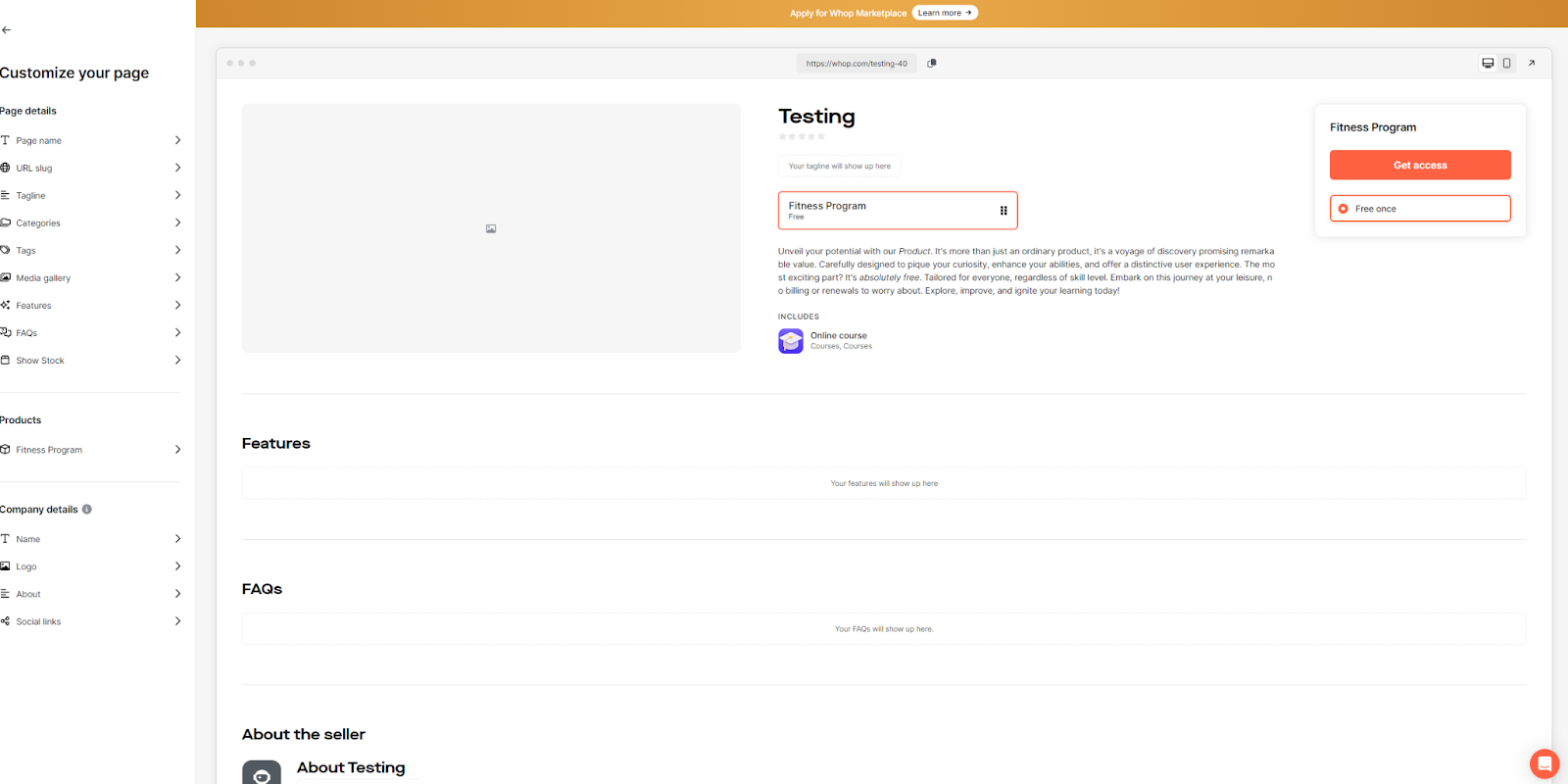
Rinse and repeat the steps above to add as many digital products as you want, from fitness programs to on-demand workouts. Next, before your store goes live in the Whop Marketplace, there are a few fun features to tend to.
Click on "Store page" on the left-hand side of the screen, and then tap on "Customize your page." This is where you can change your page name, URL, and tagline, so start with that.
Next, choose a primary and secondary category that your storefront best fits into, such as "Life Hacks" or "SaaS." Add informative, SEO-driven tags that will help customers find your store. Head on over to the Media gallery and add up to 8 images of your workout routines, meal plans, and other services that you offer.
Under the "Features" section, describe the key features of your programs—this is a bite-sized advertisement that helps your clients shop. You can also add FAQs, tweak your product listings, and add company information. We highly recommend doing this, as it adds a ton of credibility to a budding seller profile!
Final step: Apply for Whop Marketplace and set up payments
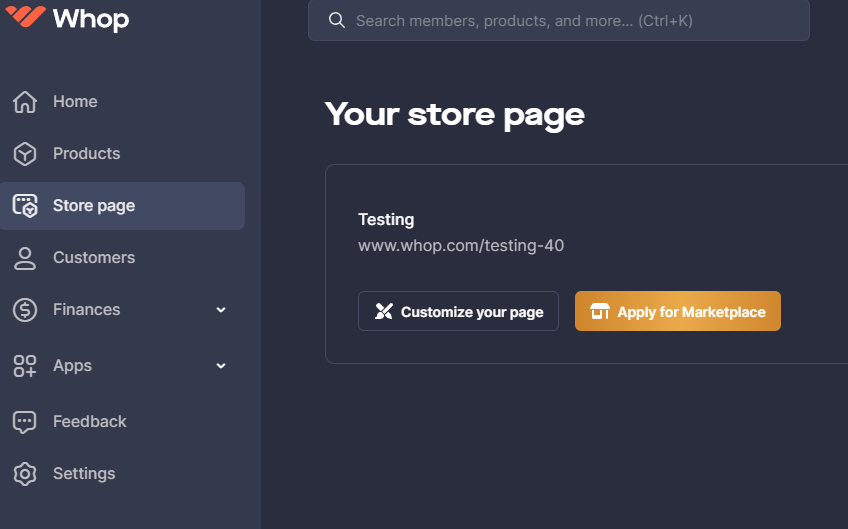
We're at the finish line. Once you're done customizing your storefront, click on "Apply for Marketplace" and wait for it to appear online. You're about to play an influential part in the fitness journeys of people all around the globe!
But wait—before you sit back and relax, make sure to set up your account so that you can get paid once the first customers appear. Head on over to the Finances tab, then click on "Payouts." Choose your country of residence and continue to Stripe where you'll set up your account and verify it, enabling you to receive payments from Whop.
And there you have it! Your online fitness programs are up for grabs, and all that remains is keeping them fresh, interacting with your community, adding new workouts and features, and scaling your business whenever you're comfortable.
Start Your Online Fitness Business With Whop Today!
Embracing the current trend of virtual fitness is the best way to go right now. Not only will your love of fitness help people all around the globe, but you'll also start building a business that can withstand the test of time. Doing this a few years from now might be a lot harder, with the market even more saturated, but if you start now, you'll be well ahead of the curve by then.
If you hesitate, remember that there's no easier way to sell fitness programs online than with Whop.
Whop is an online marketplace that lets you list any and all content related to fitness and wellness, ranging from personalized workout videos to access to exclusive meal planning or fitness-oriented communities. By working with Whop, you get the benefit of advertising your services to an existing customer base, and trust us—this is going to be huge for your sales.
With Whop, getting started takes around 10 minutes, and the Whop API platform is an all-in-one solution for selling fitness content, be it ebooks, courses, or one-on-one coaching calls.
Instead of spending time and money on things that don't help you evolve your business, focus on what can make you a successful virtual personal trainer. It's never been easier.
FAQs
How to market fitness programs online?
The best marketing strategy is one that covers all the bases. For starters, get yourself on social media, especially Instagram and TikTok, but other platforms are good to add, too. Post relevant content and engage with your audience on a regular basis to build a following.
Consider starting a YouTube channel to post workout videos and link back to your paid fitness programs. Lastly, using paid ads can also help you market your services.
How to sell a personal training program?
The easiest way to sell personal training programs is to use Whop. You can prepare fitness courses and sell them through one-off payments or subscriptions. You can also let your followers sign up for paid calls with you where you can offer even more personalized advice. Alternatively, you can sell your program through a website, an online storefront, or an app.
How to start a website selling fitness programs?
You'll need to buy some internet real estate by buying a domain name and URL, then set up your website by coding it yourself or using a website builder like Wix. However, to sell fitness programs, it's often easier to just sign up with an online marketplace like Whop, which supports secure payments and automates all the tedious tasks, such as sending course materials to your customers.
Are fitness apps profitable?
Yes, fitness apps can be profitable, especially if you market them on various channels, such as social media or online marketplaces. The global fitness app market is booming and it's expected to continue growing at a substantial rate. If you have something new to offer and a little bit of patience, a fitness app can be a good source of income, including passive income.




